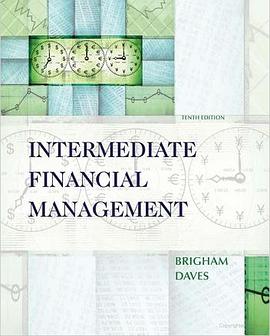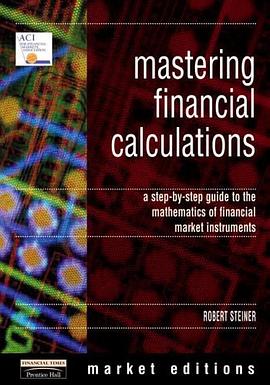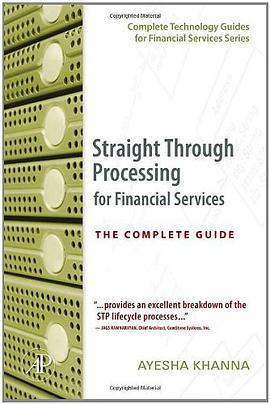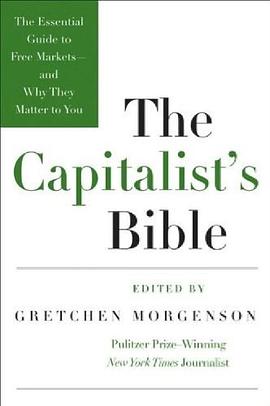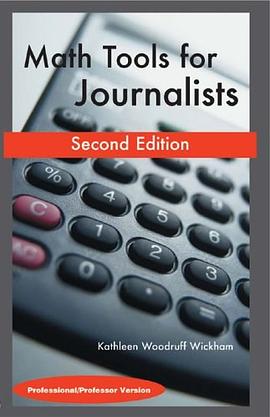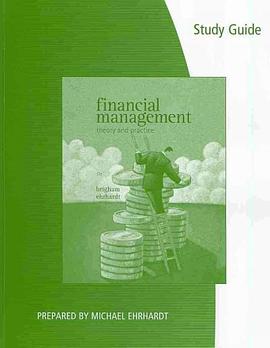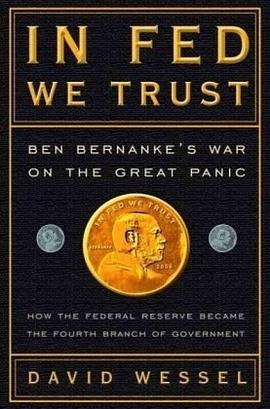

具体描述
From The Washington Post's Book World/washingtonpost.com David Wessel's "In Fed We Trust" opens on Sept. 14, 2008, when Ben Bernanke, the chairman of the Federal Reserve, is badly sleep-deprived, living on trail mix and wrestling with the decision of a lifetime. For months, he has been trying to stamp out the spreading wildfire of the international financial crisis, yet he, along with Treasury Secretary Henry Paulson and New York Fed President Timothy Geithner, can't seem to get ahead of the flames. Bernanke had slashed interest rates, helped the Treasury Department and Wall Street bail out the investment bank Bear Stearns -- and still, Wessel writes, "every time officials at the Treasury or the Fed thought they finally had gotten ahead of the Great Panic, they turned out to be insufficiently pessimistic." And on Sept. 14 the problem is what to do about Lehman Brothers. A lifelong scholar of the Great Depression and its causes, Bernanke deeply believes that the global economic crisis of the 1930s, with all its baleful political consequences, could have been avoided if the Federal Reserve had more aggressively pumped liquidity into the economy. He has also been informed that the venerable Wall Street investment firm, with hundreds of billions of dollars worth of connections to the global financial sector, is running out of cash. A second Great Depression is in the offing -- the moment, in a sense, for which Bernanke has been preparing his whole life. Yet he does not know quite what to do. No private-sector buyer for Lehman can be found. The Fed stretched its legal authority to rescue Bear Stearns the previous March, and that doesn't appear possible in the Lehman case. Paulson, for his part, was spooked by the bad political reaction to the Bear bailout and doesn't want to repeat it if he doesn't have to. And so, Bernanke, believing that the markets might have had time to prepare their defenses against a Lehman collapse, concludes in consultation with Paulson and Geithner that there is no alternative to letting the firm fail. It was the biggest bankruptcy in U.S. history, and it triggered a near-global financial meltdown. And from that moment on, Wessel argues, Bernanke was determined never to be accused of doing too little again. "Whatever it takes" became his depression-beating mantra, and under Bernanke the Fed either carried out or supported some of the most sweeping government interventions ever. Today, the Treasury owns most of General Motors and part of Citigroup and Bank of America, while the Fed funds mortgage-backed securities and the commercial paper markets to the tune of hundreds of billions of dollars. The Fed's balance sheet stands at about $2 trillion, double what it was two years ago. Did it work? Wessel, the economics editor at the Wall Street Journal, has clearly had access to all the key players; his reporter's judgment is that Bernanke does deserve credit for preventing what he aptly dubs the Great Panic from morphing into something even worse. The interventions Bernanke spearheaded cost Americans hundreds of billions of dollars, much of which necessarily flowed into the coffers of Wall Street firms such as Goldman Sachs and AIG. But the relevant question is what Americans would have paid, now and in the future, if Bernanke and his colleagues had not done what they did. From that point of view, their actions look more cost-effective. Indeed, recent data suggest that the worst may be over. The U.S. economy's shrinkage decelerated to a rate of 1 percent between April and July. The Dow Jones Industrial Average is hovering near 9,200, up 2,700 points from its lowest point of the past 52 weeks. Even housing is finding a bottom. Unemployment is at 9.4 percent and will probably peak at around 10 percent -- bad, but far from 1930s levels. Last week, the central bank said it would allow a $300 billion program to buy Treasury bonds to lapse in October, a sign that it thinks the economy can stand on its own two feet. Still, as Wessel shows, the Fed in general and Bernanke in particular were hardly blameless in the buildup to the crisis. Under former Fed chairman Alan Greenspan, the central bank probably kept interest rates too low for too long in the wake of the 2001 recession, fueling the housing boom whose bust in the second half of 2007 brought on the Great Panic. The Fed's policy under Greenspan reflected the intellectual influence of none other than Bernanke, Wessel writes, whose fear of a downward spiral made him "a strong ally of Greenspan's in making the case that the Fed should keep interest rates low and say so publicly." Bernanke on that occasion was not necessarily well served by his lifelong focus on depression economics: When you're a hammer, every problem looks like a nail. A final verdict on Bernanke's performance will have to wait until the Fed finishes the job he started. If the U.S. economy has stopped sinking, it is because of the flood of artificial liquidity, released by Bernanke, that has borne it up. The Fed's next job will be the perfectly timed withdrawal of all that extra money, so as to avoid either roaring inflation or a relapse of deflation. Bernanke's term ends in 2010, and it's clear he is itching for a chance to finish what he began, even though President Obama will be sorely tempted to replace him with a Democrat such as Larry Summers, the White House economic adviser (and Bernanke's longtime intellectual competitor). A second term for Bernanke would be a good call for Obama if he wants to preserve continuity at the Fed, and if he concludes that Bernanke's belated but creditable actions merit a reward. But in a sense, the Fed's job for the next half-decade has already been determined by the course Bernanke chose in the past 18 months. Whoever takes the helm will face the greatest liquidity mop-up in history. And only if the Fed pulls it off can there be a happy ending to the Great Panic, whose scary beginning David Wessel has so effectively narrated. lanec@washpost.com
Copyright 2009, The Washington Post. All Rights Reserved.
作者简介
..gives a revealing blow-by-blow account of the recent financial crisis”
—David Brooks, The New York Times
“...essential, lucid—and, it turns out, riveting—reading."
—Michiko Kakutani, The New York Times
“...a tale that’s nothing short of hair-raising..reveals in scary detail how unprepared politicians and regulators truly were...”
—Paul M Barrett, The New York Times Book Review
“Wessel delivers an engrossing account of Bernanke's improvisational responses to the worst financial crisis since the Great Depression.”
—Fortune Magazine
“... so far the most entertaining and most readable book on the financial crisis.”
—Tyler Cowen, marginalrevolution.com
“...persuasively told and richly reported... It will win awards and inspire copycats.”
—BusinessWeek
"David Wessel brings his deep knowledge of the Federal Reserve and U.S. politics and economics to a topic that will be studied by historians for decades to come...No one can understand what happened and what did not happen without reading this book."
–Joseph E. Stiglitz, winner of the Nobel Prize in economics and author of Globalization and its Discontents
目录信息
读后感
经济观察网 西书窗http://www.eeo.com.cn/today_media/headlines/2009/08/07/147060.shtml
评分经济观察网 西书窗http://www.eeo.com.cn/today_media/headlines/2009/08/07/147060.shtml
评分经济观察网 西书窗http://www.eeo.com.cn/today_media/headlines/2009/08/07/147060.shtml
评分经济观察网 西书窗http://www.eeo.com.cn/today_media/headlines/2009/08/07/147060.shtml
评分经济观察网 西书窗http://www.eeo.com.cn/today_media/headlines/2009/08/07/147060.shtml
用户评价
5% 把电影too big to fall的内容在第一章就讲完了。紧凑又entertaining 60% 想看当年宋子文lead的takeover了 100% 还是很balanced一个纪实。很多术语看完就忘了,但是看到主角们经历这场战役后的蜕变和世界的变迁还是挺畅快的 最后惊闻Paulson是Christian scientific教的,看来不能排,或笑话阿汤哥了,得看看教义到底是啥玩意儿了
评分5% 把电影too big to fall的内容在第一章就讲完了。紧凑又entertaining 60% 想看当年宋子文lead的takeover了 100% 还是很balanced一个纪实。很多术语看完就忘了,但是看到主角们经历这场战役后的蜕变和世界的变迁还是挺畅快的 最后惊闻Paulson是Christian scientific教的,看来不能排,或笑话阿汤哥了,得看看教义到底是啥玩意儿了
评分上学期做助教的必备功课。对于有学而优则仕的经济学生很有激发性~
评分迷信是科学之父
评分迷信是科学之父
相关图书
本站所有内容均为互联网搜索引擎提供的公开搜索信息,本站不存储任何数据与内容,任何内容与数据均与本站无关,如有需要请联系相关搜索引擎包括但不限于百度,google,bing,sogou 等
© 2026 book.quotespace.org All Rights Reserved. 小美书屋 版权所有

